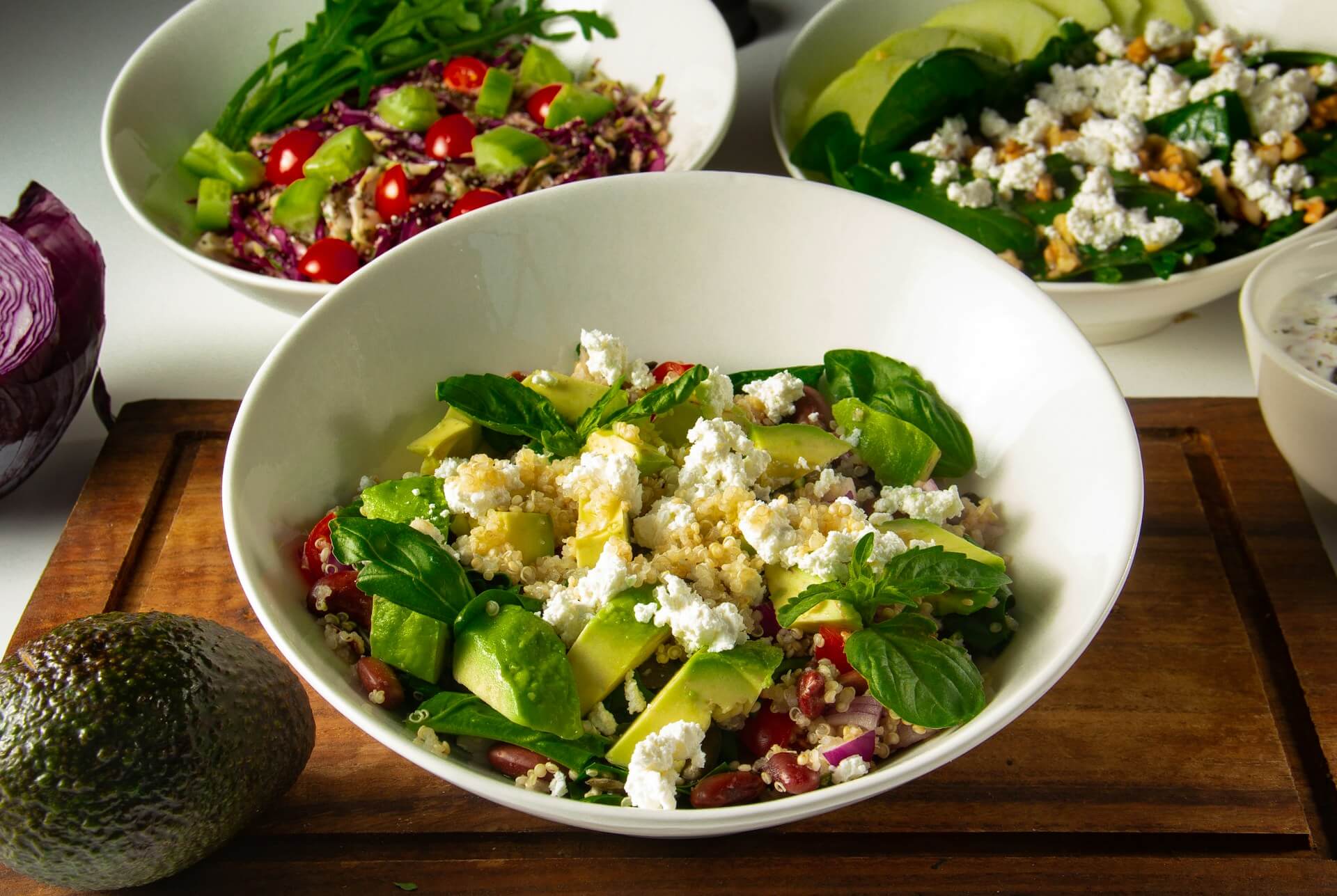Plant-based nutrition has taken the world by storm, offering a verdant, deliciously compassionate path to health and wellness. In this blog, we’ll leaf through the extraordinary benefits of a plant-heavy diet, introducing tasty recipes that redefine the term ‘salad days.’ Whether you’re a staunch vegan, a health nut looking to add some leafy verve to your life, or a home cook ready to venture into greener culinary pastures, this post is your passport to plant panache.
Cultivating Well-Being: The Health Benefits of Plant-Based Eating
The Science of Greens
Recent research has repeatedly highlighted the health advantages that plants offer. The intricate blend of vitamins, minerals, and phytonutrients in fruits and vegetables acts like a healing symphony for the body. This harmony reduces the risk of chronic diseases such as heart conditions and certain cancers and has been shown to enhance life expectancy.
A Palette of Colors for Peak Performance
Each color of the rainbow is indicative of the variety of phytonutrients in a plant-dense diet that offers unique benefits. Chlorophyll-packed greens like kale and spinach strengthen blood and immune function, while the beta-carotene in carrots and sweet potatoes improves vision and cell repair. By creating an eating spectrum, your body can enjoy a full array of proactive plant properties.
More Plants, Less Problems
Swapping animal products for vegetables and legumes has also been known to ease common health concerns. Plant foods tend to be lower in saturated fats, high in dietary fiber, and help manage blood sugar levels. For individuals with conditions like diabetes or high cholesterol, a shift towards plants can be a literal lifesaver.
The Low-Down on Digestion
Fiber plays an unsung hero in gut health, acting as a prebiotic and ensuring smooth sailing through the digestive tract. Whole grains, nuts, and seeds are excellent sources that can stave off constipation and reduce inflammation in the colon.
Cardiovascular Climbing
The heart prefers a menu laden with veggies thanks to their ability to keep blood pressure in check and arteries clear. With heart disease being a leading cause of death, such a dietary move might just provide a blend of culinary confetti and logical longevity.
Say Cheese to Calcium-Rich Greenery
Worried about bone health post-dairy? Fear not, leafy greens such as collards, kale, and bok choy are brimming with calcium. These plant sources are often more bioavailable and more easily absorbed than their bovine-based counterparts.
Rethink the Plate: Simple, Flavorful Plant-Based Recipes
Starter Pack: The Foundation of Flavor
The building blocks of a plant-based diet are diverse and exciting. Grains like quinoa and farro provide a hearty base for meals, while legumes such as chickpeas and lentils contribute a punch of protein. Nuts, seeds, and their respective butter take flavor profiles to new levels.
Power Breakfasts to Start Your Day Right
A simple chia pudding topped with a berry compote or a savory tofu scramble spiced with turmeric and pepper—these breakfasts will not only get your day off to a great start but also keep you energized.
The Cool World of Salads
Salads aren’t boring. There, I said it. A Thai-inspired papaya salad with a zesty lime dressing is a taste explosion, while a roasted vegetable medley tossed with balsamic and fresh herbs offers a comforting, earthy bite.
Super Soups for Year-Round Comfort
A virtuoso chickpea stew or Tuscan ricotta loaded with dark, leafy greens can warm the soul and fortify the body, one delectable spoonful at a time.
Bowl Over with Buddha Bowls
The beauty of Buddha bowls lies in their versatility. Aunty likes her soy? Drop in some marinated edamame. Cousin prefers things smoky? Char up some corn and add a dash of chipotle.
The “Build-Your-Own” Concept
Encourage a DIY approach with a variety of grains, roasted and fresh vegetables, legumes, and a dollop of hummus or tahini for a delectable flourish.
Seasonal Sensations
Keep things fresh and in tune with the seasons. Spring might call for a citrusy fava bean salad, while fall flavors sing in a roasted squash and quinoa bowl.
Decadent Desserts, sans Diary
With the growing availability of non-dairy milk and natural sweeteners, plant-based desserts can be more satisfying than traditional sweets without the excess dairy and refined sugars.
Creamy Concoctions
Coconut-based ice creams or avocado-rich chocolate desserts can be both creamy and indulgent. For the less calorically inclined, fruit-based sorbets serve as a light and refreshing option.
Fresh from the Oven
If you’re more of a baker, veganizing treats is a cinch with the wide range of alternatives now available. Learn to swap eggs with flax or chia seeds, and butter with coconut oil or avocado for a healthier treat.
Skillet Success: Sassy Sautés and Vibrant Veggies
The Sizzle of the Pan
The art of sautéing lies in a mix of high temperatures and swift movements. With plants, this means retaining their crispness and nutrient density while also coaxing out incredible flavors.
Aromatics and Augmentations
Start with aromatics like garlic and ginger to build a flavor foundation, and add complexity with spices such as cumin or garam masala. A splash of tamari or a swirl of miso can elevate a simple sauté to new umami-rich heights.
The Power Trio
A sauté thrives on the combination of a star vegetable, a complementary grain or protein, and a pop of texture, be it from toasted nuts or a sprinkling of seeds.
Braise and Bolden
Braising is the domain of heartier vegetables and can turn tough leaves like kale into a supple bite that soothes in every chew.
One-Pot Wonders
Compose a braise with your choice of sturdy green, a medley of roots like carrots and beets, and simmer in a rich vegetable stock. The result is a warm, comforting dish that makes one wonder how much flavor simplicity can hold.
Versatile Veggie Medleys
By jumbling together a selection of braised vegetables like eggplant, peppers, and zucchini, you can create a multi-faceted dish that can be served on its own, over rice, or tucked into a pita pocket for a mobile taste experience.
The Art of the Green Shake: Smoothie Supremacy
Power in a Glass
The convenience and the sheer healthiness of smoothies cannot be overstated. They represent nature’s fast food, a potent blast of nutrition in a humble glass.
The Formula for Fusion
A good smoothie balanced sweetness from fruits with the heartiness of vegetables or grains. Adding chia or flaxseeds injects omega-3 fatty acids, and a spoonful of nut butter can amplify the protein content.
Seasonal Specialties
From bright green spinach and pineapple to deep-purple acai and banana, smoothies can be tailored to any palate or health objective. Experiment with local, seasonal produce for the freshest flavors and maximize nutritional intake.
Sensational Smoothie Bowls
Taking the concept a step further, smoothie bowls are a work of art. The smooth, creamy base can host an array of toppings from granola to fresh fruit, creating a dish that’s as aesthetically pleasing as it is satisfying.
Play with Texture
Contrasting textures can be key. A smoothie base smooth as silk paired with crunchy nuts or chewy dried fruits can add another dimension to the dish.
Design with Delight
Don’t underestimate the power of plating. The way a smoothie bowl is presented can add to the enjoyment. A well-designed bowl can entice the eyes before the mouthwatering commences.
The Supplementation Situation
B12 and Beyond
One often-cited concern with a plant-based diet is the potential for certain nutrient deficiencies. B12, which is primarily found in animal products, should be supplemented. Iron, calcium, and omega-3s are found in abundant plant sources but may require a bit of a nutritional dance to ensure adequate intake.
The Best Laid Plans
Having a solid understanding of where to find these nutrients can ease the supplementation requirement. Dark leafy greens for iron, fortified non-dairy milk for calcium, and flaxseeds or algae oil for omega-3s can set a plant eater on a nutrient-rich path.
Mindful Meal Planning
However, it’s always good to be mindful. If a varied diet isn’t possible, it’s worth consulting a nutritionist to discuss personalized supplement plans.
Gardening in the Kitchen: Tips for the Plant-Curious
Starting a plant-based diet can be an incredibly fulfilling experience. It’s a chance to explore the vast array of flavors and dishes that the natural world has to offer. Here are a few tips to ensure a smooth transition:
Start Slow
The abrupt change in diet can be overwhelming for both palates and digestive systems. Begin by swapping out one or two meals a week.
Explore and Experiment
The world of plants is broad and adventurous. Don’t be afraid to try new things, from jackfruit to nutritional yeast. Each foray is a step into an uncharted, deliciously novel direction.
Community Counts
Connect with other plant eaters for support and ideas. From local meetups to online forums, there’s a growing community eager to share experiences and advice.
Learn the Lingo
Terms like ‘macrobiotic,’ ‘raw,’ and ‘whole-food, plant-based’ can come in handy when seeking out recipes and resources tailored to specific dietary paths.
Keep It Simple
Especially in the beginning, focusing on straightforward recipes with familiar ingredients can build a solid foundation for more complex plant-based cooking adventures.
The plant kingdom offers an endless bounty of not just sustenance, but flavor, health, and sustainability. The path to a plant-based plate may be one of the most impactful journeys you can take, for your well-being, for the animal kingdom, and for the very planet we share. It’s a leafy quest that I hope you’ll find as exciting and rewarding as I have. Now, grab a spatula, and start creating your leafy legacy!





